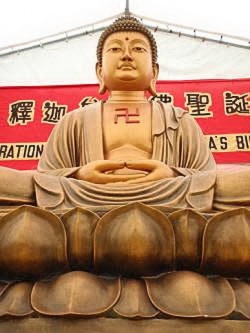Difference between revisions of "Difficult-to-practice way"
| Line 4: | Line 4: | ||
[[難行道]] ( [[Jpn nangyo-do]] ) | [[難行道]] ( [[Jpn nangyo-do]] ) | ||
| − | One of the two ways of [[Buddhist practice]] mentioned in [[Nagarjuna's]] Commentary on the [[Ten Stages Sutra]], the other [[being]] the easy-to-practice way. The difficult-to-practice way refers to the exertion of strenuous [[effort]] in austere practices for many [[kalpas]] in [[order]] to attain [[enlightenment]]. It means the [[attainment]] of [[enlightenment]] through one's own [[power]]. In contrast, the easy-to-practice way means to call upon the names of [[Buddhas]], relying upon their [[power]] of {{Wiki|salvation}} to attain [[enlightenment]]. The [[Pure Land]] ([[Jodo]]) school interprets the difficult-to-practice way as the practice of any [[sutra]] other than the three basic [[sutras]] of that school (the [[Amida]], [[Buddha]] [[Infinite]] [[Life]], and [[Meditation]] on the [[Buddha]] [[Infinite]] [[Life]] [[sutras]]), and the easy-to-practice way as that of calling upon the [[name]] of [[Amida]] [[Buddha]], relying solely on his [[power]] of {{Wiki|salvation}} to attain [[enlightenment]]. | + | One of the two ways of [[Buddhist practice]] mentioned in [[Nagarjuna's]] Commentary on the [[Ten Stages Sutra]], the other [[being]] the [[easy-to-practice way]]. The [[difficult-to-practice way]] refers to the exertion of strenuous [[effort]] in austere practices for many [[kalpas]] in [[order]] to attain [[enlightenment]]. It means the [[attainment]] of [[enlightenment]] through one's own [[power]]. In contrast, the [[easy-to-practice way]] means to call upon the names of [[Buddhas]], relying upon their [[power]] of {{Wiki|salvation}} to attain [[enlightenment]]. The [[Pure Land]] ([[Jodo]]) school interprets the [[difficult-to-practice way]] as the practice of any [[sutra]] other than the three basic [[sutras]] of that school (the [[Amida]], [[Buddha]] [[Infinite]] [[Life]], and [[Meditation]] on the [[Buddha]] [[Infinite]] [[Life]] [[sutras]]), and the [[easy-to-practice way]] as that of calling upon the [[name]] of [[Amida]] [[Buddha]], relying solely on his [[power]] of {{Wiki|salvation}} to attain [[enlightenment]]. |
</poem> | </poem> | ||
{{R}} | {{R}} | ||
Revision as of 15:42, 17 September 2013
difficult-to-practice way
難行道 ( Jpn nangyo-do )
One of the two ways of Buddhist practice mentioned in Nagarjuna's Commentary on the Ten Stages Sutra, the other being the easy-to-practice way. The difficult-to-practice way refers to the exertion of strenuous effort in austere practices for many kalpas in order to attain enlightenment. It means the attainment of enlightenment through one's own power. In contrast, the easy-to-practice way means to call upon the names of Buddhas, relying upon their power of salvation to attain enlightenment. The Pure Land (Jodo) school interprets the difficult-to-practice way as the practice of any sutra other than the three basic sutras of that school (the Amida, Buddha Infinite Life, and Meditation on the Buddha Infinite Life sutras), and the easy-to-practice way as that of calling upon the name of Amida Buddha, relying solely on his power of salvation to attain enlightenment.
